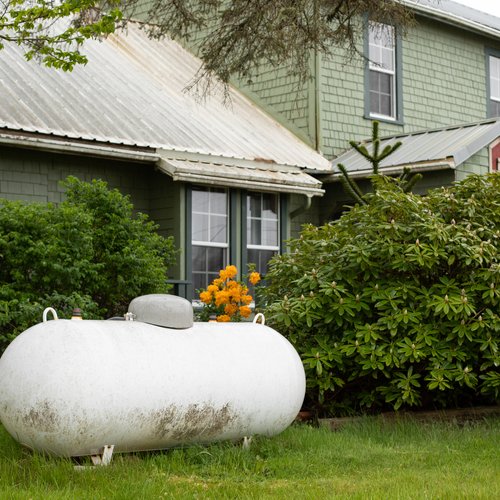Are you one of the 50 million Americans relying on propane gas to heat your home this winter? Well, then kudos are in order! Using propane not only reduces greenhouse gas emissions, it also helps you save on energy costs. But there is one major con when it comes to using propane as your primary energy source: that enormous monstrosity in your yard: the propane tank.
Depending on how big your home is, these oblong tanks can range in size from 120 gallons (almost 6 feet long by 2 feet wide) to over 1,000 gallons (about 15 feet long by 3.5 feet wide). Here’s how you can take your propane tank from eyesore to decor.
1. Paint your tank
Yes, you can give your propane tank a colorful makeover! Adding some color and design just might make you like the way it looks. And this nifty transformation will set you back only the cost of a few cans of primer and paint. Painting your tank is a good strategy because it doesn’t require a lot of money or effort. Everybody looking at your tank will still know what it is, but it won’t look as bad.
Depending on the overall outdoor aesthetic of your home, you may choose a classic natural color that blends into your yard, such as brown or green. Or you can opt for a more eclectic design. Just keep in mind that your county or propane supplier might have certain restrictions on your color choices. For example, it may advise against painting your tank a dark color if it gets lots of sun. So always be sure to check with the supplier before crafting your perfect propane tank masterpiece.
2. Fence in your tank
Building a fence is another great option for disguising the eyesore that is your propane tank. And while it will cost you a few more bucks than a simple paint job, it can result in you not having to see the tank at all. Fencing a propane tank in is an easy DIY option. You can buy a ready-made fence or build your own. You can then hang planters on the fence to make it more aesthetic. Remember to check with your local regulatory authorities before you start, as some municipalities only allow you to add a fence on two sides of the tank while others may not let you do it at all.
The cost of fencing in your tank will vary based on its size and how much you’re legally allowed to cover. According to a fencing cost guide from HomeServe, you should plan on spending anywhere from $10 to $35 per linear foot on materials if you choose to do it yourself. However, if you prefer to have a ready-made fence installed, prepare to spend $15 to $60 per linear foot.
3. Landscape around your tank
Painting or fencing not your style? Then you might try adding some lush tank-covering greenery. If you’d rather keep the tank as invisible as possible while still striving to make the area look beautiful, add some landscaping. Landscaping like shrubs or ivy—especially when accompanied by a small fence or lattice—can make the enclosure feel like a natural fit into the exterior of your home. Plan on spending a few hundred dollars to buy plants that are large enough to disguise your propane tank properly.
4. Bury your tank
While it’s probably the most expensive option on this list, burying your tank is a great way to go if you don’t want to see even one bit of it in your yard. To bury a 500-gallon propane tank, you’ll need to dig a hole approximately 5 feet deep, 5 feet wide, and 10 feet long. Make sure you place the tank in the sand for drainage and backfill it with sand or clean fill to prevent damage to the coating. You’ll also need to keep a few inches exposed to allow service access to valves and regulators.
Unless you love digging, it’s best to leave this job to the pros. You’ll also need to budget anywhere between $1,600 and $2,100 to get the job done. And remember to always check with your propane company before changing anything about your tank.


Recent Comments